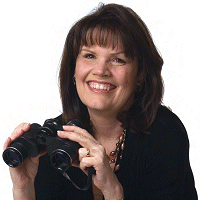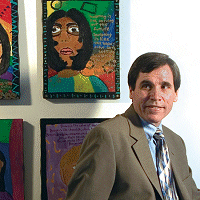Visionaries :: Vision Quest
##AUTHORSPLIT##<--->
How can you see the world like an ed tech leader? Start by checking yourself for a trio of qualities common to the industry's most creative thinkers.
IT WAS A COOL Paris morning in 1742, and the vision of the Marquis de Bacqueville was about to be realized: human flight. He had declared that, using only his own power and four wings made of starched linen, he would fly across the Seine River from his mansion on the quay at the corner of the Rue des Saints Pèresand touch down in the Tuileries, a distance of about 500 feet.

IN FOCUS: A visit to the schoolcomputer
lab with a class ofspecial needs kids changed
Ann McMullan’s perspectiveon the potential
of educationtechnology to reach students.
A large crowd having gathered, the moment had arrived. Perched on a terrace extending out from one side of the mansion, the marquis took a deep breath, readied his wings, and propelled himself into space.
Moments later, he dropped like a rock and broke his leg when he landed atop a washerwoman’s barge. Thereafter, he challenged to a duel anyone who mentioned the abortive flight.
Lesson learned? It takes more than a vision and perseverance to be successful. This is especially true in the field of educational technology. The efforts of the marquis notwithstanding, a good idea is the first thing one needs to get off the ground. But let’s assume that providing educational technology to the world is manifestly a good idea and focus on three essential qualities that supplement a vision:
- a sense of adventure
- a commitment to students
- an ability to build coalitions
All of the educators you’ll read about here believed in their own abilities to promulgate the idea that technology can help educate students, and were powered by these three characteristics in executing their visions. Some of them were more deliberate than others. Some were more focused. But by having a sense of adventure, making a commitment to students, and building coalitions, all of them have made a significant difference in improving educational opportunities for students everywhere.
A Sense of Adventure
You’re a CIO for a school district, and you think that a laptop computer for each of your students would be a tremendous asset. However, you don’t tell anyone because you think:
- The funding’s not there.
- The district doesn’t have the knowhow to implement such a program.
- The teachers wouldn’t accept the new hardware without training, and they don’t have the time for training.
- The students wouldn’t treat the laptops responsibly.
- Many parents wouldn’t support giving their children unchecked access to the internet.
Consequently, you never know if in fact your students would have benefited from the laptops because you never even tried to acquire them. What doomed your idea before it ever had a chance? You did—namely, your lack of a sense of adventure. In a way, this is the most critical of the three characteristics. A good idea withers if the person with the idea is reluctant to propose it.
Jim Hirsch has a sense of adventure. He’s the associate superintendent for technology and academic services at the Plano Independent School District, a suburban Dallas district of 53,000 students and 170 staff members. He’s been in Plano since 1996. In this time he has: developed a digital user interface through which the district’s network recognizes every student and staff member on any of its more than 30,000 computers and delivers their personal desktops directly to them; helped implement an 81-milelong fiber-optic network that carries voice, data, and digital video as well as a 116-channel private analog video network to 80 sites; and ushered in an awardwinning elementary school curriculum project that integrates technology in every classroom and provides district standards for hardware, software, staff development, and support.

"I learn the most from our students.
I watch what they're doing in thehall,
in Starbucks. That's how we’regoing
to capture them—by providingthem
learning opportunitieswherever they
happen to be." —Jim Hirsch,
Plano Independent School District
Hirsch is sometimes characterized as a “visionary with detail” because of his ability to embed promising technologies into daily classroom activities.
Hirsch was always ahead of the curve in understanding the impact computers could have on education. Years ago, as a math teacher, he helped students understand slopes by having a computer plot them: “It wasn’t convenient,” he says.“You had one large—20-inch—TV set.The picture wasn’t good, but the kidscould see it come to life. You could followthe computer doing it.” Hirsch’ssense of what could be was sparked.
For Hirsch, bringing forth his vision of technology in the classroom was part calculation, part serendipity. He spent both personal and professional time exploring different software, different hardware, different pedagogies. He began to talk with teachers in their computer labs; he started unofficial user groups. “It became a hobby,” he says.
It was Hirsch’s sense of adventure that held these groups together. He lives by trial and error. “I never look at the documentation first,” he says. “I just like to go out and explore.” That he did. With a goal of enlivening the classroom, he’d suggest uses for both software and hardware that weren’t in the documentation, such as using different printer drivers on computers with a variety of software programs. At the time, that kind of mixing and matching was something that people just didn’t do.
Hirsch is always pushing the boundaries, twisting perceptions, transforming. To Hirsch, personal computing is “more than a laptop. It’s a sustainable model that provides students access to resources when they need them, where they need them.” Whereas many purported visionaries take their cues from their colleagues, Hirsch looks elsewhere: “I learn the most from our students. I watch what they’re doing in the hall, in Starbucks. That’s how we’re going to capture them— by providing them learning opportunities wherever they happen to be….They’ve got 10 minutes; what’s wrong with them using the word processor to continue the thought they just had? Most people don’t think about that.”
A Commitment to Students
A sense of adventure is necessary but doesn’t amount to much by itself. If the overriding goal of educational technology is to benefit students—and let’s stipulate that it is—then a commitment to students needs to be made.

“You have to keep people motivated, recognizethem, prod them, say, 'We can do better.'
— Keith Krueger, Consortium for School Networking
Consider Ann McMullan. In the 1990s, she was teaching eighth-grade history in the Klein Independent School District, north of Houston, to a class of 15 boys and three girls. Some of the students had special needs. It was her most challenging class, and McMullan and her co-teacher used a lot of different strategies to try to reach the kids. One day the class got their first experience with computers—dial-up Macintosh systems. “I was dumbstruck the first time I took them to that Mac lab,” says McMullan. “They were just mesmerized.” She called all her colleagues and implored them, “You’ve got to come see this.” From that day on, everything was different.
McMullan started attending technology conferences and was amazed at what could be accomplished. Her knowledge grew, and she was soon hired by the systems application department at the district level to teach her colleagues about technology. In the 1997-1998 school year, after Klein ISD switched to PCs, she helped acquire funds for ed tech tools. Soon she moved into her current post as the district’s executive director of educational technology and had a major role in creating state standards that established the teaching of K-8 technology skills as an integrated component—that is, they’re embedded in each subject. That means, says McMullan, that “all your teachers become technology teachers.” It also means that all the students remain the focus of the technology.
After 18 years as a history teacher, McMullan never expected to leave the classroom. “I really enjoy the students,” she says. But witnessing the transformation in her students that day in the computer lab clarified her goals, gave them focus. She thought, These are the people we serve. “If we’re going to demand that students spend 12 or 13 years with us,” she says, “it shouldn’t be drudgery.”
Having seen how technology could be used to help educate students, she committed herself to motivating others to link technology with education, first by bringing teachers into technology-oriented classrooms so they could see the benefits for themselves, and then by procuring the support of key administrators.
McMullan believes fiercely in education’s need to embrace current technology, lest it lose its relevance. “It’s not just in the schoolhouse,” she says. “It’s in the world around us. Those who were waiting for it to go away—it’s not. This revolution is about information and communication. If we don’t change inside the schoolhouse while everything is changing outside, we’re lost. We need to do right by kids today, and we need to do right by their future.”
Building Coalitions
Generally, no one succeeds alone. The most successful plans are usually those that have a wide base of support. The more you can excite others about your idea—your vision—and the more you can enlist their support, the greater your ultimate chances are for success.
Witness Don Knezek’s professional arc. Knezek is the CEO of the International Society for Technology in Education. Before coming to ISTE, he ascended to leadership positions in local school districts, the regional education service center, the Texas Department of Education, and the US Department of Education. All along the way, he built coalitions by getting people enthused about what he wanted to do; he calls it“setting the agenda.” In fact, what originallyattracted him to ISTE—he firstworked there as a volunteer—was “theway we get out in the field, shoulder toshoulder with educators.”
Coalition building has been intrinsic to Knezek’s work at ISTE. He has built relationships with Hewlett-Packard, Microsoft, Intel, and Learning.com. Sometimes Knezek needs knowledge, sometimes promotion, sometimes just an endorsement. “We find providers,” he says, “who can offer support in a lot of different ways.”
The process for building coalitions, Knezek says, involves “a great deal of listening and watching to know how bright a spark is struck in potential collaborators…. The toughest part is exploring strategies and alternatives until we together craft details of the undertaking and an approach to it that provides what I need and what the other collaborators need.”
Once the vision is shared, Knezek says, then the benefits of coalition building emerge: Everyone is supportive of each other, as well as the goal.“We seem to be able to pull very positive,productive things out of people.We don’t do a whole lot alone, and welike it that way….For acceptance, adoption,and advocacy for the effort, collaborationis critical.”
David Martin would second that. Collaboration was critical to Martin’s effort to promote his revolutionary idea for a touch-sensitive display that would connect to a computer and digital projector to show images, which could then be controlled from a computer or from the images themselves. Martin called it the Smart Board, the world’s first interactive whiteboard, and as the chairman, co-CEO, and co-founder of Calgarybased Smart Technologies, he introduced the device in 1991.
“I conceived of the idea of tying...a display to a personal computer, a telecommunications link, and the interactive whiteboard,” he says. “Someone writing on the Smart Board could have this information transmitted to multiple remote meeting or learning locations.”
It was a great idea, but it couldn’t blossom until Martin could get people to see the future as he saw it. After 18 months of trying to drum up interest in personal computer conferencing, Martin was approached by the senior vice president of Intel, who shared Martin’s vision of the PC merging with the world of telecommunications. But did Smart want a partner? For Martin, the choice was between spending the time and resources of his entire staff of 28 pushing forward with his product, or solidifying the relationship with Intel. As he says now, alliances are fraught with responsibility:“When you say yes to an organizationlike Intel, you have to deliver on it orthere’s no point in taking the phone call.”
In April 1992, Smart put on a demonstration at Intel’s national conference. The coalition was forged, and it paid dividends for each. Intel gave Smart credibility; Smart gave Intel a successful product. Smart was Intel’s sixth investment. Today, the tech giant’s investments exceed 1,000.
More testimony to the ability of coalition building to get results comes from Keith Krueger of the Consortium for School Networking (CoSN). While working with the National Institutes of Health and the Library of Congress, Krueger soon learned that in order to get anything accomplished politically or legislatively, it was essential to join forces. That, he says, is one of his strengths,“having educators coalesce with policymakers….Things don’t happen with justone person.”
Krueger has applied a belief in coalition building to promote his dual vision: the transformation of society through information technologies, and a unified voice for K-12 educational technology, a future he works toward through his position as CoSN’s CEO.
Krueger has taken coalition building international. As a result of the trip he took last fall to South Korea, Singapore, Hong Kong, and Australia, CoSN has launched a joint international research project involving Australia, the United States, and the United Kingdom to investigate new ways to measure the value of education technologies in those three countries.
He continually coordinates advocacy, policy, and leadership development with individuals representing school districts, states, nonprofit organizations, and corporations. He bands together school board members, superintendents, district personnel, principals, and policymakers.
“You have to make sure that people see what’s in it for them and [work toward] a larger purpose,” Krueger says, explaining his approach. “You have to keep people motivated, recognize them, prod them, say, ‘We can do better.’”
:: web extra ::For more information on visionaries, visit T.H.E. Journal. For more on a variety ofrelated topics, try the Browse by Topic menu.
Neal Starkman is a freelance writer based in Seattle.